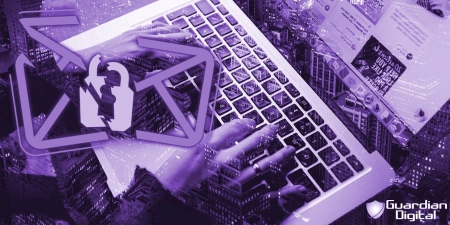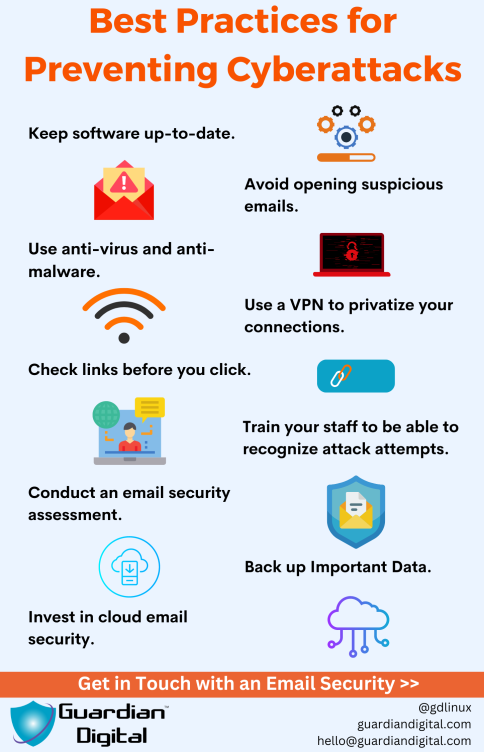A cyberattack is an attempt to break into, damage, or disrupt a system or network, usually for financial gain or access to sensitive data.
Most begin with email. Email is still the top delivery path for malware and phishing. The 2025 numbers show the same pattern: most breaches succeed because an attacker convinced someone to click.
For companies already stretched thin, those numbers explain why so many never fully recover after an incident. The impact of a cyberattack isn’t just lost data — it’s downtime, costs that pile up quickly, and customers who don’t return.
What Do Hackers Do in a Cyberattack?
Hackers probe for weaknesses until they find one that gets them in. Some use phishing campaigns that mimic vendors or coworkers. Others launch ransomware to lock systems and demand payment.
Many target email directly because it’s easier to trick an employee than to break through hardened firewalls. Once they’re in, stolen credentials or a single infected attachment can be enough to take control.
Why Are Cyberattacks a Growing Threat?
Cyberattacks are rising because sensitive data is more valuable than ever, and attackers know defenses haven’t kept pace. Verizon’s 2025 Data Breach Investigations Report shows just how common these attacks have become — ransomware was involved in 44% of breaches, and incidents tied to third parties doubled to 30% in a single year.
These types of cyber attacks aren’t isolated. The fallout hits harder than just system repairs. Recovery costs, lost trust, and reputational damage can linger long after systems are back up. That’s why cyber attack prevention isn’t a checklist; it’s an ongoing strategy. The growth of these threats demonstrates how the definition of a cyberattack continues to expand.
What Common Cybersecurity Threat Involves Human Interaction Skills?
Social engineering is an attack that works by tricking people instead of breaking software. Phishing emails ask for logins or push fake invoices. Phone calls pose as support staff to get credentials. It slips past defenses because the weak point isn’t the system, it’s the user.
Training helps reduce mistakes, but the better answer is stopping these messages before they ever reach an inbox.
What Are the Most Common Types of Cyber Attacks?
The most common types of cyber attacks are familiar: phishing, ransomware, and malware. What changes is the way they’re packaged and delivered. Attackers reuse the same methods with new disguises because the basics still work.
- Phishing – The baseline attack. It’s cheap, fast, and still works because one convincing email can get a click.
- Spear phishing – A more targeted version. One crafted message aimed at a specific person can slip through where a bulk blast won’t.
- Ransomware – No longer rare. Hospitals and school districts have been locked out of their own networks for weeks while attackers demand payment.
- Malware – Often hidden in an attachment or link. Some strains sit quietly until triggered, which is why they’re so hard to spot.
- Man-in-the-middle – Less common, but effective. Attackers slip between two parties, stealing data without raising alarms.
- Brute force – Automated tools that keep hammering passwords until one finally gives.
- Insiders – Whether careless or deliberate, they bypass every perimeter defense a company has.
Listing the types of cyber attacks only matters if it points to where the risk begins. In practice, that’s the inbox. Most breaches start with an email that feels ordinary enough to open.
Which Types of Cyberattacks Commonly Target Faculty and Staff?
Faculty and staff are hit hardest by phishing, spear phishing, and ransomware. Universities trade in trust and open communication, which makes them easy marks. A fake password reset, a research file share, or a billing request can all be it takes. One wrong click and credentials are gone, systems are infected, or sensitive student data is exposed.
How Can Businesses Protect Against Cyberattacks?

Most cyberattacks start simple. One email lands in a mailbox, the user clicks, and from there, an attacker has a way in. That’s why defenses built only around spam filters or password rules don’t hold up. Updates, multi-factor authentication, and backups matter, but the real test is whether targeted emails get stopped before people ever see them.
Small and mid-sized businesses face the hardest reality here. Budgets are thin, IT staff are limited, and attackers know it. That’s why small to medium business email protection is critical — it gives smaller teams access to the same layered defenses larger enterprises already rely on. Without that, one missed phish can become a shutdown that lasts days.
How to Prepare for a Cyber Pandemic?
A cyber pandemic is the scenario where one strain of ransomware or phishing spreads across industries all at once. We’ve already seen versions of it when ransomware families crippled hospitals and schools in the same week.
Preparing for that kind of attack means testing incident response plans, keeping offline backups ready, and using cloud-based spam filtering that updates in real time to block mass phishing before it spreads. Companies that build resilience this way don’t just survive the first hit — they recover faster than the rest.
Cyberattack Protection with Guardian Digital
Spam filters catch the easy stuff. They don’t catch the email crafted for a specific employee, or the shared doc that hides ransomware, or the insider who clicks without hesitation. Those are the openings attackers wait for.

Guardian Digital was built to close those gaps. EnGarde Cloud Email Security blocks phishing, credential theft, and ransomware before they reach users, and it shows where the pressure is building — which accounts are being hit, what threats are landing most, and how those patterns shift over time.
For teams running Microsoft 365 or Google Workspace, that visibility changes the game. You’re no longer guessing what got through — you see it and can move on it before it spreads.
The benefits extend beyond immediate protection. Companies see ROI through reduced downtime, fewer incidents, and more productive staff. The open-source foundation provides transparency and resilience that other vendors don’t match.
Managed support lightens the load for overworked IT teams, while complete visibility enables better planning and policy enforcement. For organizations already stretched thin, those advantages matter as much as the blocking itself.
That’s what cloud email security should mean: not just filtering, but real-time awareness and defenses that adapt as fast as the attackers do. Anything less is just keeping out junk mail while the real threats walk in.
Keep Learning About Protecting Against Cyberattacks
Cyberattacks aren’t going away, and the tools behind them aren’t standing still. Phishing kits are cheaper, ransomware groups run like businesses, and attackers keep looking for the one mistake that opens the door. The companies that hold up best are the ones that treat security as ongoing work — not a one-time setup.
That means building awareness into daily operations, layering defenses so the inbox isn’t a blind spot, and preparing for recovery before it’s needed. If ransomware can still take down hospitals and schools, every organization has something at stake. Our ransomware guide breaks down how those attacks unfold and what stops them.
Staying ahead also means staying current. New campaigns and tactics surface every week, and the difference between prevention and cleanup often comes down to timing. You can get updates straight from our team by joining the newsletter.





